
2015.2 | 2015.1 | 2014.2 | 2014.1
2013.2 | 2013.1 | 2012.2 | 2012.1 | 2011.2 | 2011.1 | 2010.2 | 2010.1
2009.2 | 2009.1 | 2008.2 | 2008.1 | 2007.2 | 2007.1 | 2006
August – December 2007
- December 2007 Newsletter – Nov 30
- October 2007 Newsletter – Oct 2
- August 2007 Newsletter – Aug 1
December 2007 Newsletter
Shows, Exhibitions, and Auctions
- There’s Something About Munich
Bill Larson’s follow-up on 44th Mineralientage München, 2007 - Musée des Cristaux, Chamonix, France
- Natural History Sale at Bonhams & Butterfields
- Tucson 2008 Theme: “Minerals of the U.S.A.”
Pala International News
Minerals and Mineralogy News
Publications
- Italian Gemological Review
Pala’s gems shower the cover
Shows, Exhibitions, and Auctions
There’s Something About Munich
Bill Larson at the 44th Mineralientage München, 2007
Monday afternoon, October 29, I pick up my lifelong friends Erica and Harold Van Pelt on the way to LAX and an outbound Lufthansa flight to Munich. We have time together to catch up on many things, including our excitement of seeing the special exhibit of gems and minerals from the “roof of the world”—the Himalayan mountains: Afghanistan, Pakistan, and Nepal.
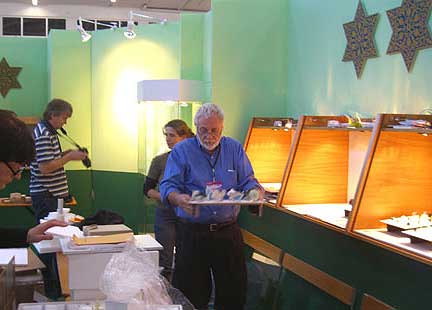 |
| That’s no salad bar. Herb Obodda, an authority on precious stones of the Himalayas, carries some of his specimens to be included in this year’s special exhibition at the Munich show. (Photo: Bill Larson) |
This will be the 44th annual Munich Mineralientage. I applaud Johannes Keilmann, his lovely family, and his great staff for putting on the finest and largest mineral and gem show in Europe. What a great effort—and it shows. I remember from the mid 1970s a much smaller show (albeit a very charming one). I have visited the Munich show more than 30 times.
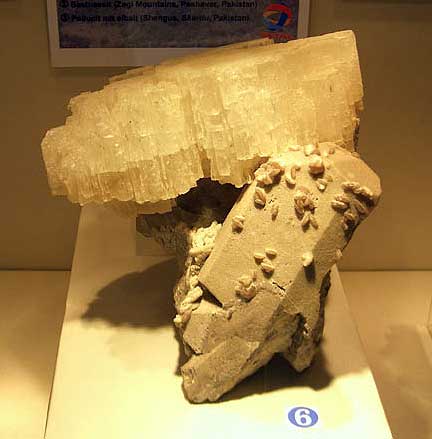 |
| From the land of Rumi. This Afghan beryllonite, courtesy the National Museum of France, is perhaps the finest specimen of its size, (Photo: Bill Larson) |
The Hotel Seibel and the Krone are in downtown Munich and still house many of the collectors/dealers of the Munich show so I stay here and commute by U-bahn. Simple and efficient, the underground goes right to the Messe (fair). I arrive at the show on Wednesday morning and activity is all around the three halls. Little is set up yet and I see a few of the usual suspects, many American collector and dealer friends, including Scott Wersky, Ross Lillie, Victor Yount, Mike Bergman, Andy Seibel, Bill and Carol Smith, and Barry Yampol. Each of us have friendly European dealers who hope to show us something first, but the competition is fierce and fun.
I am most excited about the special exhibit but it will not start to be set up until tomorrow. I greet each dealer in the pavilion for advanced mineral specimens and get a realization of what the dollar buys at 1.44 to the euro; this time purchases must be specific and carefully negotiated. I have a large customer base and long-term relations with Munich dealers, so I am able to get a few fine selected things in this first day.
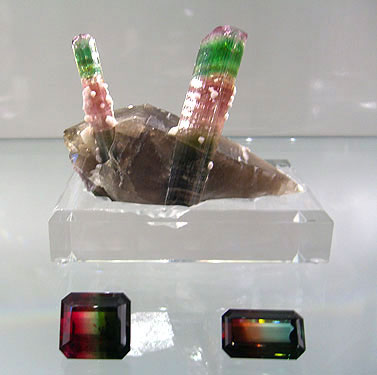 |
| Multi-color tourmaline. This display came complete with its own soundtrack. (Photo: Bill Larson) |
Thursday I am still hunting fine minerals and gems, but by noon I’m invited to help set up the special exhibit with a few friends contributing specimens. Kudos to Keilmann for purchasing the special cases that many of us have gone to in the Westward Look show. Custom-made anodized metal in black or (as here in Munich) white, with a myriad of fiber optic lights to highlight gems and minerals with heat-less but intense light. Herb Obodda is featured both in the show catalog and in the display. and he is busy setting up not only the collections he showed in Tucson but many more. The National Museum of France has a great selection of rare minerals including the finest large beryllonite I have seen.
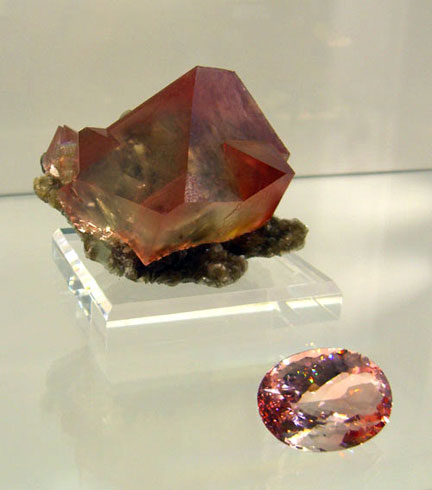 |
| Fluorite. One of the rough/cut pairs from the whitecases at the Munich show. (Photo: Bill Larson) |
The central whitecases are being set up with minerals from various sources and the pieces are all superb. The large multi-color tourmaline in its special case is well lit, with haunting Enya music surrounding it. A special opening for the special displays starts at 6 p.m. for invited guests and this is a fun time. Also the special mineral pavilion has a dinner for invited guest and I shuttle between them both.
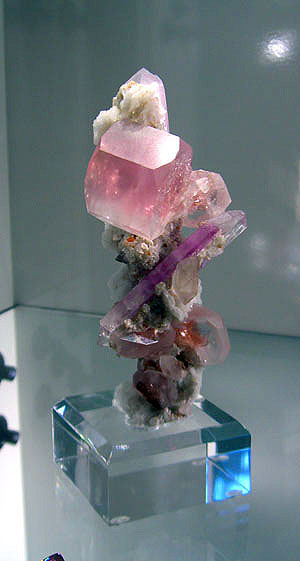 |
| Morganite and kunzite. Another jazzy composition by Mother Nature. (Photo: Bill Larson) |
Friday the special cases are now finished, and this is dealer day, fun to walk and talk. Lots of fine minerals are now set up in all the dealers’ booths. I meet up with Tom Moore, who is writing the Munich show up for The Mineralogical Record, and we compare notes on new finds—few this year, but interesting. See his column in the next issue!
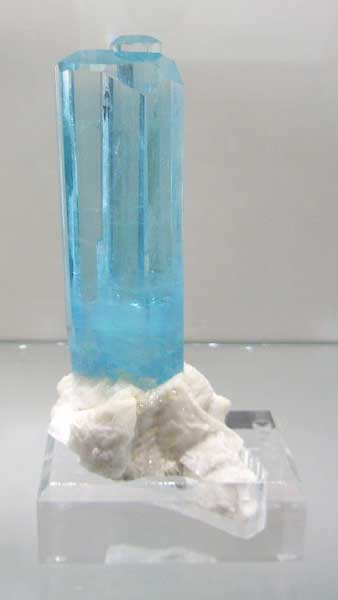 |
| Aquamarine. Limpid and lovely. (Photo: Bill Larson) |
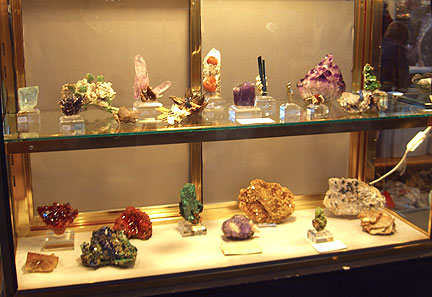 |
| A dealer’s case shows the variety of offerings at the Munich show. (Photo: Bill Larson) |
[back to top]
Musée des Cristaux
At l’Espace Tairraz Chamonix Mount-Blanc
During Bill’s visit to the Munich show he stopped in at the Musée des Cristaux (Museum of Crystals) in Chamonix, which lies at the foot of Mont Blanc in eastern France. The museum was built in collaboration between the local Mineralogy Club and the city of Chamonix. Its purpose is to display and explain the region’s geology and subsequent mineral formations, focusing on the world-famous smoky quartz and fluorite deposits. On display now is an exceptional red fluorite crystal, seen on the right side of the image below. Visit the museum website (in French). [back to top]
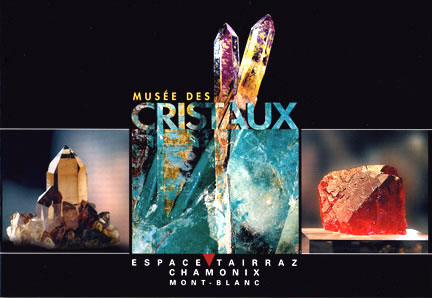 |
| Museum booklet cover highlighting the 3.7-kg. red fluorite crystal that measures 10 cm. |
Natural History Sale at Bonhams & Butterfields
Shock & Auction
Bonhams & Butterfields is holding its Winter Natural History sale in Los Angeles on Sunday, December 2, at 11:00 am. The auction includes fine fossils, minerals, lapidary works of art, meteorites, amber, jewelry, and gemstones. For information on the sale, visit Bonhams and Butterfields.
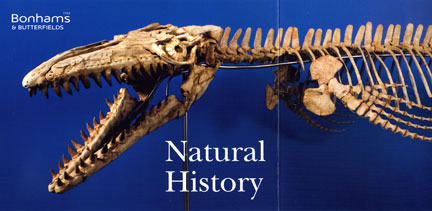 |
Some of the rarities on offer:
- An anydrite from Chihuahua, Mexico with a large crystal “resembling a New York skyscraper,” according to the catalog (Lot No. 1187)
- A large 16 x 10 inch slice of Argentine rhodochrosite stalactites, “grown together to form... beautiful adjoining circular patterns” (Lot No. 1224)
- A malachite pocket with velvet stalactites from Congo, with an amazing number of “concentrated, undamaged, stalactites flaring off the plate” (Lot No. 15418)
- Rough and cut kunzite from Minas Gerais, Brazil, from the estate of W. M. Grieger, originally in the collection of Jack Halpern (Lot. No. 1247) [back to top]
Tucson 2008 Theme: “Minerals of the U.S.A.”
Home Grown Minerals
At the upcoming 54th Annual Tucson Gem and Mineral Show in February we will revisit the great mineral localities found with the U.S. borders. Highlighted in “Minerals of the U.S.A.” will be some of the great finds, as well as the people involved with the mining. The main display cases will be filled with some of the classic specimens found right here at home.
Augmenting the display will be the release of a hard-cover book, American Mineral Treasures (ISBN: 978-0-979099-8-2), which “will describe the history and collecting adventures at more than 40 top U.S. mineral specimen-producing localities and will illustrate with superb, full-color photographs our remarkable American mineral heritage.” [back to top]
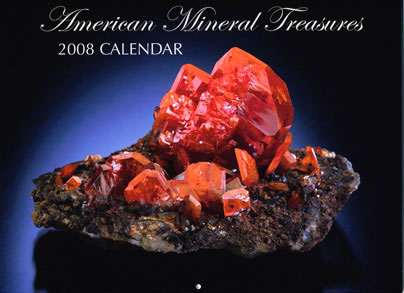 |
| We picked up this calendar at the Denver show in September. |
Pala International News
Pala’s Featured Mineral Specimen: Dioptase and Quartz
This month we feature an exquisite dioptase and quartz specimen from the Tsumeb mine in Namibia. A delightfully sparkly piece with a larger version of drusy quartz coating the surface; individual crystals measuring about 3 to 4 mm. The little quartz crystals overlay a thin layer of dioptase, which can be seen from the back.
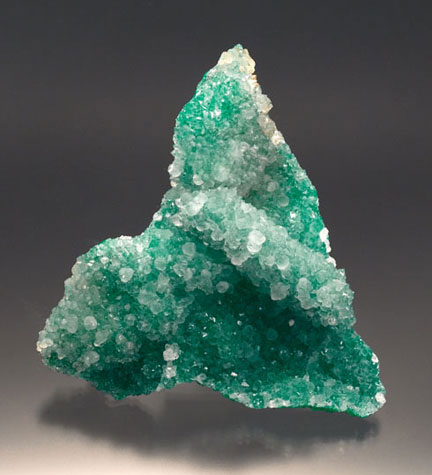 |
| Lights on out front, showing the character of the quartz crystals. Specimen is 11 x 8 x 0.6 cm. Price upon request. (Photo: Wimon Manorotkul) |
At first glance the clear quartz crystals seem to have a soft green background, but when you use transmitted light the piece glows vivid green. The dioptase-laden back side brings out a different character when backlit, as seen below. The morphology of the underside seems to be a cast of some sort, creating the undulating surface.
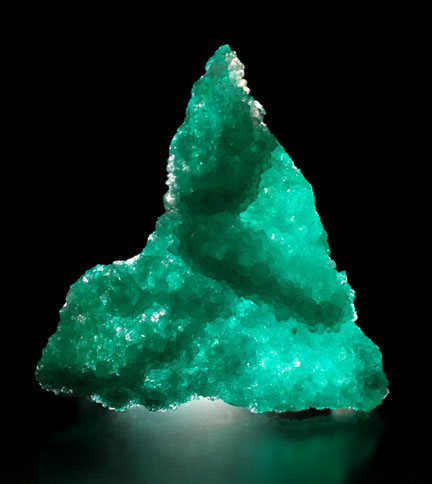 |
| Lights on from the back, showing the neon green of the dioptase layer. Specimen is 11 x 8 x 0.6 cm. Price upon request. (Photo: Wimon Manorotkul) |
Minerals and Mineralogy News
Pala District Pegmatite Opens Wide
Oceanview Mine Strikes It Big
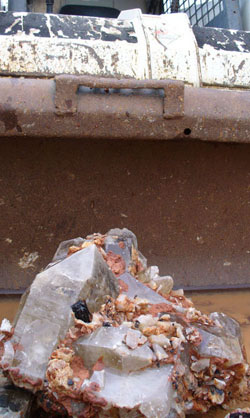 |
Pala International’s Jason Stephenson went up to the nearby Pala Mining District on Oct 13 to visit some of the local mines and talk with a few miners who are still actively hunting for gems and minerals.
Jason was invited by Roland Reed, who owns and operates the Elizabeth R mine. Roland’s mining operations began in 1973 and he has definitely put in a lot of underground square footage. It was reported by Sinkankas (1997) that Roland had single-handedly driven more than 300 meters of tunnel, which led to a few significant finds of morganite-bearing pockets. The productive years were 1974–1975 and 1982, producing about 100 kg. of morganite specimens with crystals up to 13 cm. across. Roland struck another rich pocket zone in 1992 that produced the finest morganite specimens in Southern California, according to Sinkankas (1997). This treasure had a large cleavelandite base, about 50 cm. across, with seven large morganite crystals up to 15 cm. mixed with some smaller ones. The morganites were euhedral and glassy with some pale aquamarine cores, similar in color scheme to the aquamarine cluster pictured below (Fisher 2002).
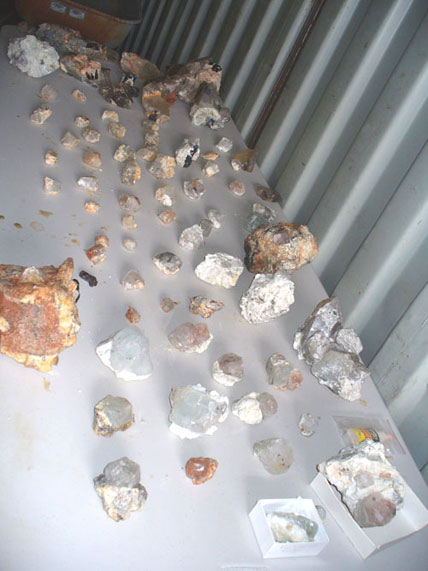 |
| The loot. Minerals recently pulled out of the 49er pocket, mostly blue and pink beryl crystals and matrix specimens. (Photo: Jason Stephenson) |
Then, in 2000, the Oceanview mine, which was originally above the Elizabeth R, was sold to Jeff Swanger. Jeff took over mining operations below the Elizabeth R and carried the original name with him. The new Oceanview tunnel started and Jeff and crew began their search for the pegmatite. Jeff’s mining operations crew consists of Phil Osborn, Steve Carter, Mark Baker, and Peter Renwick. Jeff knew that there had been significant finds of morganite-bearing pockets in the same pegmatite just above in the Elizabeth R mine, so the chances of hitting mineral-rich pockets were promising. A 400-foot main tunnel had been established with several branches leading up to intersect the pegmatite. After several years of tunneling to reach the rich zone of the pegmatite, the workings have yielded a few mineral-rich zones with a variety of minerals from feldspars, quartzes, tourmalines, spudomenes, and beryls, along with some rare ones.
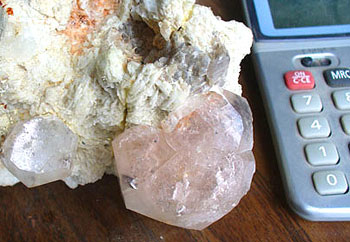 |
| With a bubble on top. View of the glassy termination where the bubble can be seen. (Photo: Jason Stephenson). |
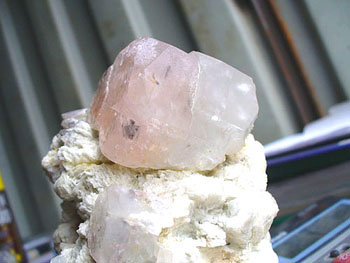 |
| Bicolor beryl on matrix. Half morganite, half aquamarine, with a bubble in the glassy top, seen on the left of the crystal. (Photo: Jason Stephenson) |
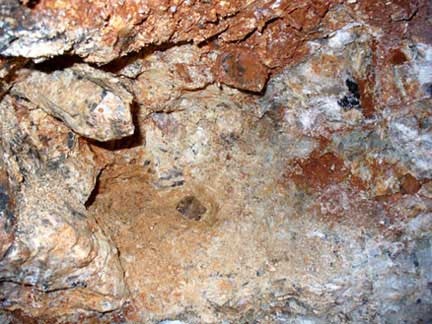 |
| The pocket close up reveals clay-laden crystal points and a glassy morganite crystal face, seen just left of center. (Photo: Jason Stephenson) |
The most recent and notable find was made on September 22, 2007. This underground surprise coincided with Jeff’s birthday and has been named the 49er pocket for one—maybe two—obvious reasons. This most recent discovery has yielded a beautiful selection of beryls, gemmy quartz, intricate aquamarine clusters on matrix, tabular morganinte crystals, and a complex dodecahedral-like beryl crystal with pink in the middle and a blue rind. The ultimate specimen was a bicolor (half morganite, half aquamarine) hexagonal crystal with a bubble showing through a glassy termination on top of a clevelandite/quartz matrix. Some large quartz clusters were also removed from the pocket intact, weighing several hundred pounds, as shown in the photo at the top of this article.
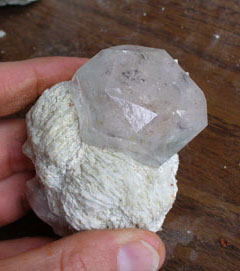 |
| Dodecahedral-like beryl. This jewel has a complex termination with glassy faces on a clevelandite matrix. Also noteworthy is the pink core and blue rind. (Photo: Jason Stephenson) |
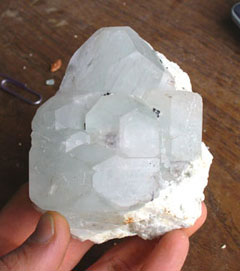 |
| Aquamarine cluster. A beautiful network of tabular crystals with a glacier-like feel. (Photo: Jason Stephenson) |
Bill Larson and son Carl went up to the Oceanview on November 23 to see for themselves this exciting new discovery. Amazingly Jeff and crew were still digging out the same mineral-rich pocket zone. This long pocket had continued to produce a variety of berlys, smoky quartz on feldspar, large citrine clusters, and dark purple tourmaline crystals.
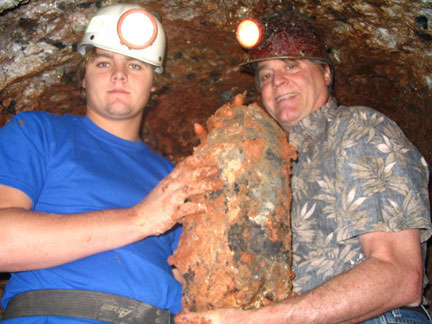 |
| Manhandling. Carl Larson and his father Bill get palsy-walsy with a specimen in the Oceanview mine. (Photo: Phil Osborn) |
Information on gem tours and digging is available through the The Oceanview Gem Mine. [back to top]
Publications
Italian Gemological Review
Pala's gems shower the cover
The growth of Palagems.com has created increased traffic through our web pages. The brilliant and vivid pictures seem to attract gem and mineral enthusiasts, from the novice collector to the scientific researcher. These advanced studies into physical and chemical analyses of unique minerals and gems produce important findings (and accompanying graphs and tables) relating to the composition and the elements that produce unique and electrifying colors. The authors also look for appealing images to complement their rigorous studies. Hard work on the scientific side seems to be well balanced when you can show a beautiful picture of a gem that is born of these unique geological and chemical conditions.
The shower of gems shown on the cover Italian Gemological Review are all from the new find of copper-bearing tourmalines from Mozambique. The crystal shown is a liddacotite tourmaline (12 cm., Shatany Valley, Madagascar; from Tiziano Bonisoli), exhibiting the full range of colors. The faceted stone photos were taken individually by Pala’s Wimon Manorotkul and assembled with the specimen photo (photographer unknown) by the good fellows at the Rivista Gemmologica Italiana. We wanted to share this cover as a well-designed incorporation of gems and minerals. See more about the publication here. [back to top]
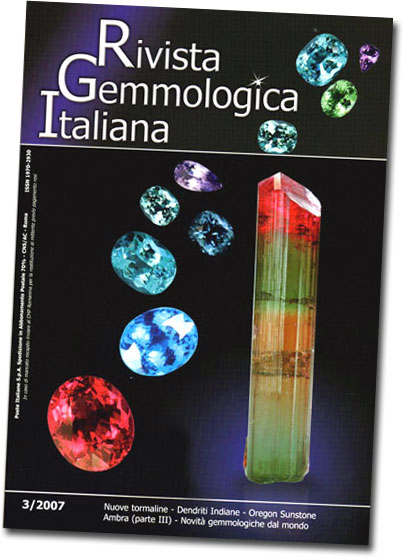 |
— End December Newsletter • Published 11/30/07 —
October 2007 Newsletter
Shows and Exhibitions
Pala International News
Minerals and Mineralogy News
Books
Shows and Exhibitions
Hillman Hall of Minerals and Gems
Wertz Gallery: Luxe Life
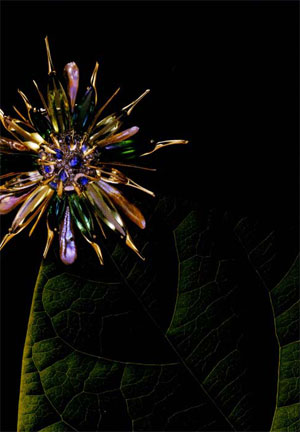 |
| From the invitation to last week’s opening of the Wertz Gallery. Sunflower Brooch by Nicholas Varney. |
Last Friday, Pittsburgh’s Carnegie Museum of Natural History opened its Wertz Gallery: Gems and Jewelry in the newly renovated and expanded Hillman Hall of Gems and Minerals. The inaugural exhibit is entitled “Luxe Life: Masterpieces of American Jewelry.”
Mineral lovers take note: The museum’s website explains that the new permanent, 2,000 square foot gallery is a
signature exhibit area dedicated to gems, the crystals from which they come, and jewelry comprised of these precious stones. … Exhibits in Hillman Hall present minerals in the manner of sculpture, shown for their beauty as well as for their physical properties and economic uses. … Approximately 500 gems, crystals, jewelry and other pieces of gem art will be on display in the permanent collection of Wertz Gallery.
For more information see the Hillman Hall of Minerals and Gems. You can also take a virtual tour of the hall’s mineral specimens. [back to top]
What’s Hot in Tucson DVD
Hosted by David Wilber
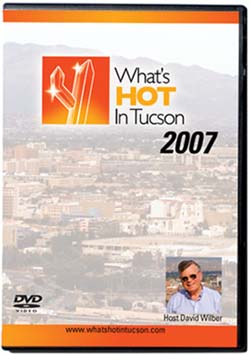 |
Here’s how we’ve been talking about this program:
- First-of-its-kind live-action DVD program dedicated to providing the mineral enthusiast a recap of the hottest specimens at 2007’s Tucson show
- Many behind-the-scenes segments that show mineral specimens you wouldn’t normally see there
- Hosted by long-time friend and mineral collecting pioneer David Wilber
- Features many of the top dealers in the industry including Pala International
- Perfect for preparing the viewer for the 2008 show
- Two weeks of Tucson compressed into one 2-hour show
- Retails for $24.95 but all friends of Pala International can use a special link that will automatically give visitors a 10% discount
Interested? Use the following link to receive a discount for being part of Pala’s network of friends and associates: What’s Hot in Tucson 2007. [back to top]
Pala International News
Pala’s Featured Mineral Specimen: Malachite Pseudomorph
In this edition of Mineral News we feature a velvety malachite after azurite specimen with a big bladey crystal and intricate secondary clusters. This material has reportedly been pulled out of the ground in the last year. This piece is said to be one of the best specimens from the new discovery in Chihuahua, Mexico.
The quality of the new find has been compared to the material found in Arizona, from the Tiger Mine, and Namibia from the Tsumeb Mine. The true classification of this deposit is still being qualified amongst the great finds in Arizona and Namibia, but the specimens are definitely a refreshing sight. The malachite takes on a velvet luster and has a sheen that moves like a chatoyant gem.
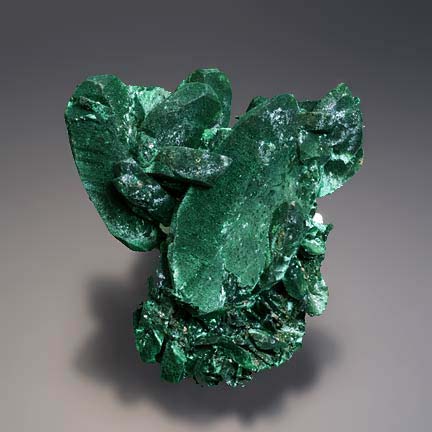 |
| Malachite pseudo after azurite, 8.3 x 7.6 x 2.8 cm. This specimen has been sold. (Photo: Wimon Manorotkul) |
This new find of malachite pseudomorphs from Mexico seemed to be the only new find that was producing any noteworthy specimens at the show last month in Denver.
Visit our mineral search for a selection of malachites from around the world. [back to top]
Minerals and Mineralogy News
Meteorite Slams into Andes Mountains
Illness affects locals in the aftermath
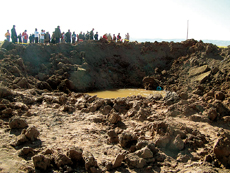 |
| Securing the area. Local people install eucalyptus-wood barriers supplied by a neighboring municipality. (Photo: La República) |
A meteorite landed in a remote region of Peru near the town of Carancas, Puno Region, the night of September 15. The UFO was seen plummeting to Earth in the southern Andean region of Peru near the Bolivian border.
The crater made by the object was 30 m. (98 ft.) wide and 6 m. (20 ft.) deep. Scientists have not been able to determine exactly what the foreign object is composed of, but concerns have grown after many visitors to scene have complained of headaches, vomiting, and nausea after inhaling gases around the crater. Reasons for these symptoms have been reported as reactions to sulfur and arsenic fumes released from the ground, and simply overreactions by the onlookers caught up in the mass hysteria and anxiety caused by the media frenzy.
The complete story can be seen at BBC International News. Another story can be seen at Space.com. [back to top]
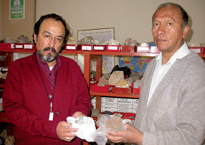 |
| Space junk? Geologists in Puno confirm that the impact was that of a meteorite—not an American satellite, as the Russian newspaper Pravda is said to have reported. (Photo: La República) |
Green Crystals in 2500-Year-Old Tomb
Well preserved tomb also yields gold foil and jade pendant
Chinese archeologists discovered several pieces of an unidentified green crystal growing on bones in a 2,500-year-old tomb in the southeastern province of Jiangxi, according to the official Xinhua News Agency. Previous discoveries of white crystal formations in tombs were determined to be crystallized amino acids.
The tomb is believed to date back to the Eastern Zhou Dynasty, which spanned roughly 500 years beginning in 770 B.C.E. The coffins and contents were extremely well preserved. The main coffin, which weighed over a ton, included “a round, exquisitely made piece of gold foil as well as a jade pendant in the shape of a dragon,” according to the article.
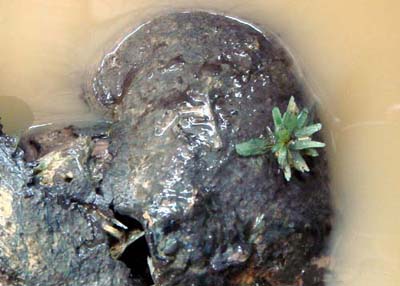 |
| Bone blossom. “Diamond” shaped crystals grow from the remains found in a 2,500-year-old tomb. (Photo: China Internet Information Center) |
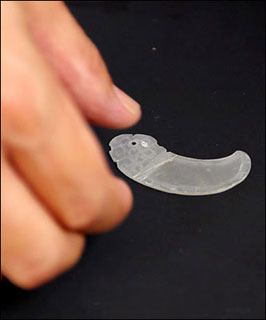 |
| Dragon pendant. This jade artifact, along with a round gold foil, was found in what is called “the largest group of coffins ever discovered in a single tomb in China.” (Photo: China Internet Information Center) |
[back to top]
Books
Fine Minerals of China by Dr. Guanghua Liu
A Review
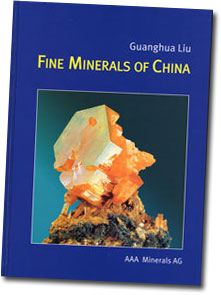 |
In our premier issue of Mineral News last year, we mentioned a new book by Dr. Guanghua Liu, Fine Minerals of China. At last month’s show in Denver we finally laid our hands on it—and it was worth the wait. Fine Mineral of China encapsulates the diverse and widespread mineral deposits of China into a well-categorized encyclopedia of data.
Part One includes historical discussions of China’s physical and political geography, and the fluctuations in mining technology. The book also describes the geologic history and follows the major tectonic events that created some of today’s large ore deposits. The history of mining is traced back over two millennia, and up through the modern age of the mineral specimen business.
Guanghua Liu’s book takes notice of the differences between the Western type of scientific collecting and the Chinese search for the artistry in nature’s sculptures. The Chinese seem to value aesthetic form and suggestive imagery while the West places value on crystal perfection, minimal human intervention, and precise locality.
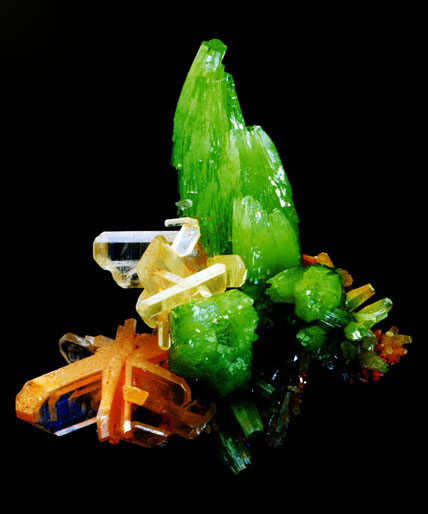 |
| Pyromorphite with cerusite, 3.5 x 2.7 mm., from the Daoping mine in the Guangxi Zhuang Autonomous Region. (Photo: Jeff Scovil, page 78) |
The core of the book—Part Two—focuses on 45 of China’s greatest mineral localities with detailed maps and vivid photos. Sections are broken down by province and deposits within the provinces are described by location, general interest, mining history, accessibility, and major collectible minerals. Part Three entails data compilation with tables by mineral locality, species, and an interesting record of meteorite falls dating back to 2133 B.C.E.
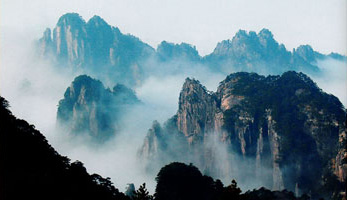 |
| A mountain of minerals. Mount Huang, Anhui Province (page 26). |
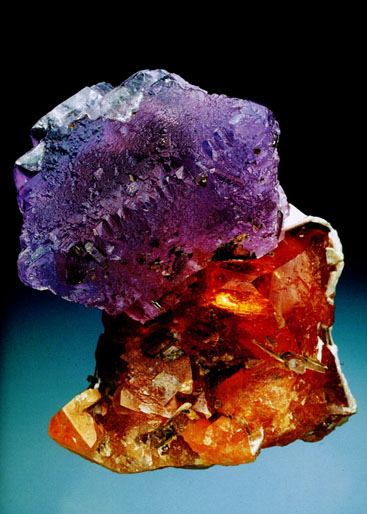 |
| Fluorite on scheelite, 0.6 cm. high, Xuebaoding Mountain, Sichuan Province. (Photo: Jeff Scovil, page 295) |
Fine Minerals of China is available through The Mineralogical Record. [back to top]
— End October Newsletter • Published 10/2/07 —
August 2007 Newsletter
Shows and Exhibitions
- Pala at Colorado Mineral & Fossil Show – September 12–16, 2007
- Gemstone Treasures from Namibia through December 2, 2007
- Sainte-Marie-aux-Mines 2007 – Bill Larson Reports
- Flashes of Colour: Legendary Wines and Gemstones – Follow-up
Pala International News
Minerals and Mineralogy News
Books and Periodicals
Shows and Exhibitions
Pala at Colorado Mineral & Fossil Show
September 12–16, 2007
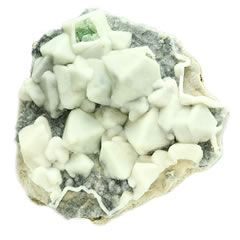 |
| Quartz casts after fluorite from Columbine, in La Plata County, Colorado, 7.7 x 8 x 3.3 cm. This specimen is available. (Photo: Jason Stephenson) |
Pala International will be at the Colorado Mineral & Fossil Show.
- When: Sept. 12–16, 2007
- Where: Holiday Inn Denver–Central, 4849 Bannock St.
- Room 183
- Hours:
Wed.–Sat.: 10 a.m.–6 p.m.
Sun.: 10 a.m.–5 p.m.
We look forward to seeing our many friends there. For more information visit the show website.
Visit the Pala International Show Schedule for future events. [back to top]
Gemstone Treasures from Namibia
June 30 – December 2, 2007
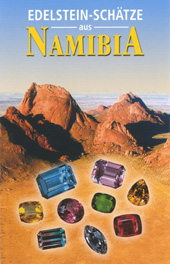 |
If you happen to be in Germany this year, try to catch this exhibition: “Gemstone Treasures from Namibia,” which includes mineral specimens and faceted gemstones. Featured in the exhibit are diamonds from Lüderitz, green beryl from the Rossing Mountains, aquamarines from the Erongo Valley, tourmalines from Karibib, and cuprites from Onganya.
As Bill Larson was jet-setting around Europe in July, he was able to see this extraordinary exhibit. He even managed to capture a photo of a dioptase specimen that landed on the pages of the new edition of Namibia: Minerals and Localities, reviewed below. (If you can’t make it over to Germany, this book is probably the next best thing.) See more show details at Deutsches Edelstein Museum.
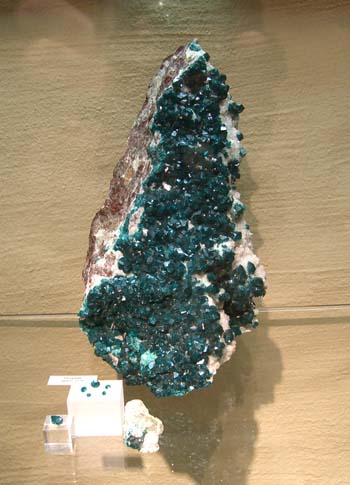 |
| Dioptase rough & cut. Display case featuring gem materials from Namibia. The large dioptase specimen happens to be featured in the new edition of the book Namibia: Minerals and Localities, reviewed below. (Photo: Bill Larson) |
[back to top]
Sainte-Marie-aux-Mines 2007 – Bill Larson Reports
Sainte-Marie is still my favorite show for minerals. The fact that it’s set up like a street fair, with a party atmosphere, combined with the great local cuisine (foie gras on every menu) and the wonderful local Alsace wines (chilled pinot noir rouge) makes this a hard act to compete with.
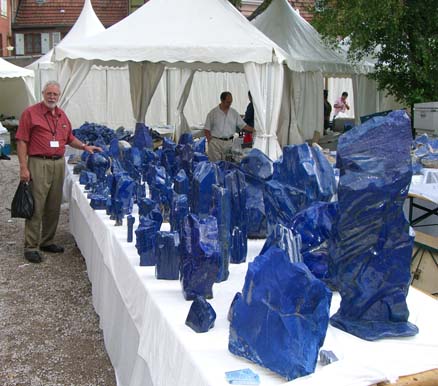 |
| Lapis lazuli anyone? Even with Herb Obodda’s (pictured above) expertise in all things “Afghany” he wonders how many backpacks were worn out carrying this lot of lapis down the mountains from the Sar-e-Sang Mine. (Photo: Bill Larson) |
The show is split into two areas: the original area with 650 dealers from 60 countries, and a newer area about one kilometer away featuring gemstones, jewelry, and beads with another 300 international dealers. A small tourism “train” shuttled between the two shows at regular intervals.
This year’s show had a few important changes. Michel Schwab continued to upgrade the “theatre” area (local landmarks house both dealer booths and exhibitions). Fewer, but finer, displays from the dealers, which were included there, make this area of the show more sophisticated—somewhat like the Munich show’s special dealer area, where the best minerals are shown. Two other enclosed buildings were filled with dealers set up along tables like in years past in the theatre. Many dealers come from all over the world with minerals, fossils, and meteorites. For collectors like myself, there are even a few book dealers.
There are also special displays set up for the public. This year’s display featured minerals with a spherical shape. I was amazed so many species could form this way.
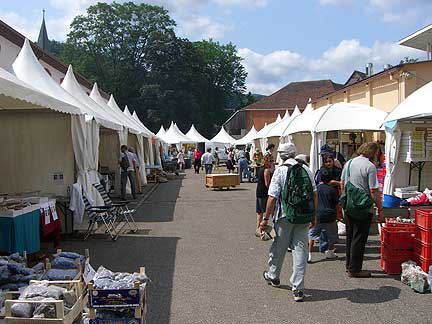 |
| Umbrellas optional. A typical street scene of vendors in Sainte-Marie-aux-Mines—on a day without rain! (Photo: Bill Larson) |
This year there were few new mineral finds; however, there was a new find of siderite. These were large lustrous crystal groups, some with quartz, from Saint-Pierre-de-Mésage, Isère, in eastern France. They were similar to the famous ones found at the classic locality of Allevard-les-Bains, also in Isère. About forty excellent pieces were recovered, the finest going to the French National Museum of Natural History, and the rest sold out to a few French dealer/collectors in the first setup day.
Other interesting finds were some new rutiles from Kipushi, in southern D.R. Congo, the best of which looked similar to cyclic twins from Magnet Cove, and some small but beautiful gem quality titanites (sphene) on matrix from Imilchil, in central Morocco. These later titanite pieces could be world class if the locality is worked more and luck is with the miners to produce larger pockets.
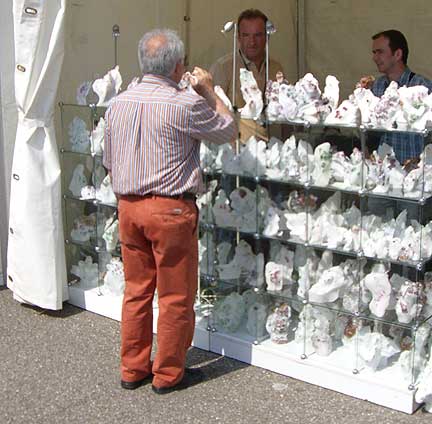 |
| This stand, by French mineral and fossil dealer Pinguaud Diffusion, shows so many calcite “sculptures” with ruby or spinel crystals, I’m reminded of what I’ve seen at the actual Luc Yen mine itself, in Luc Yen, Vietnam. (Photo: Bill Larson) |
The Sainte-Marie show for 2008 is featuring special displays of “watermelon” slices of tourmaline, from private collections, and is sure to be a great event.
To see more snapshots from the 2007 show, visit the official website. [back to top]
“Flashes of Colour: Legendary Wines and Gemstones”
A Follow-up Report
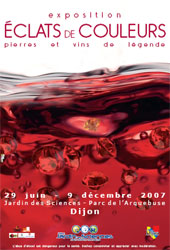 |
Last month, Bill Larson attended “Flashes of Colour: Stones and Wines of Legend,” an exhibition in Dijon, France, featuring Pala International gems and mineral specimens.
The show is produced in partnership with the French National Museum of Natural History and the Interprofessional Bureau for Burgundy Wines, as well as the Jules Guyot Institute (a winemaking school) and the UNESCO Chair of Wines and Culture (a cultural and scientific networking body).
“Travel addicted gemologist” Vincent Pardieu, whose photographs have graced our newsletters, read about the show in Le Règne Minéral, and had the following to say in relation to gemstones and wine.
It seems that you will be soon “chevalier de l’ordre Tastevin.” That’s great and as grandson [of] a French wine maker (you know now the origin of my given name) I wanted to congratulate you about it! I found the idea of that expo great as regarding colored gemstone marketing. I feel that the gem trade could learn a lot from what was done in the wine trade: In both cases these are products from the ground, there are multiple small producers, and there are treatments—“sugar diffusion” for Champagne and “heat treatment” for Cognac, Armagnac and even Porto wine. Anyway, they were able to find ways to protect their names and give their product some quality image.
The show continues through December 9, 2007. Read more here (in French).
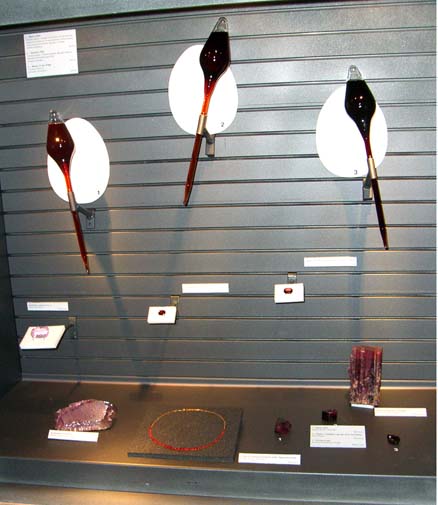 |
| Color in different forms. This exhibit compares the color in wine and gemstones. The custom-made flasks (top) allow the color of these classic reds from Burgundy to be appreciated without oxidation. The large tourmaline at lower right is from Pala, California, and was mined shortly before it was gifted to National Museum of Natural History in 1904. (Photo: Bill Larson) |
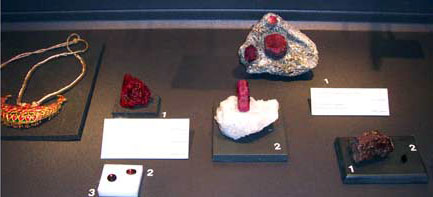 |
| These rough and cut rubies and spinels help set off some of the fine red wines. At left is an antique necklace encrusted with rubies. (Photo: Bill Larson) |
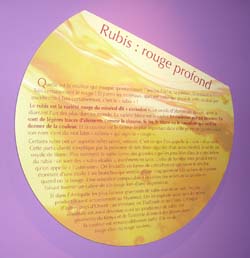 |
| Profound. Bill loved the sense implied by a cursory English translation of this placard. It actually means Ruby: deep red. (Photo: Bill Larson) |
[back to top]
Pala International News
Pala’s Featured Mineral Specimen: Azurite
In this edition of Mineral News we feature an azurite cluster on matrix.
This dramatic specimen consists of four interlocking azurite crystals atop a dark black and green host. The azurite crystals are well formed blades with nice glassy terminations and sleek striated sides. The crystals have a blotchy dark blue-to-greenish blue exterior, with some electric blue translucency. The largest azurite crystal measures 33 x 20 x 9 mm.
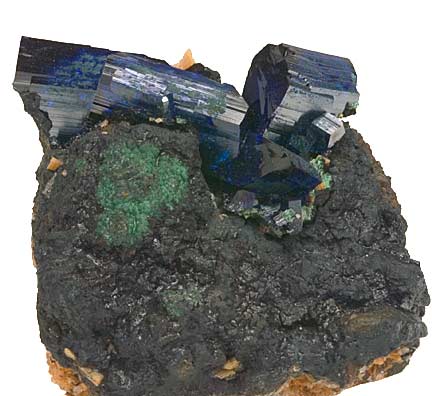 |
| Azurite specimen, 6.7 x 5.8 x 5.6 cm. This specimen has been sold. (Photos: John McLean) |
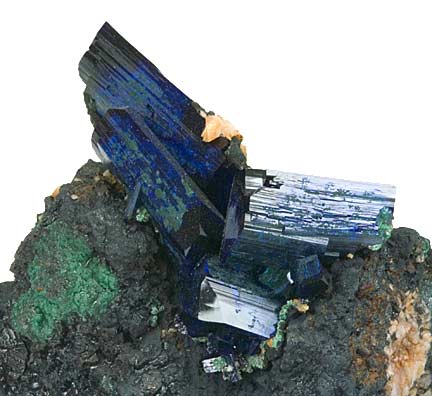 |
This azurite specimen was collected in the Touissit Mine, south of Oujda, in eastern Morocco. This piece was originally part of Dr. Eric Asselborn’s collection. [back to top]
Pala’s Sphere of Interest
This sphalerite sphere glows with enchantment
This mineral oddity captured Bill Larson’s esoteric eye at last month’s Sainte-Marie show—although even the layman can appreciate its subtle beauty. In transmitted light we see a rich amber–honey color with only a few inclusions. Overhead light reveals the metallic luster in a silvery skin.
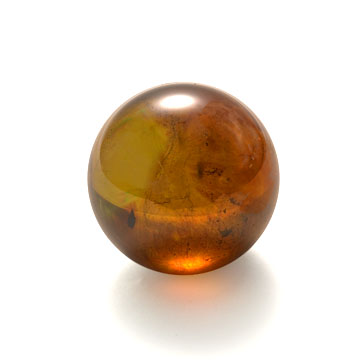 |
| Sphalerite sphere. From Spain; diameter 51 mm; weight 1,395 carats. Price upon request. (Photo: Wimon Manorotkul) |
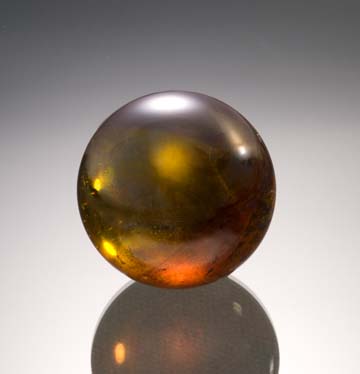 |
The stone is from the famous Las Manforas Mine, at Aliva, in the Picos de Europa Mountains located in the southwest of Cantabria province, on the coast of northern central Spain. Indeed, the name of the province itself is thought to mean place of the “people who live in the rocks” (Wikipedia). [back to top]
Minerals and Mineralogy News
Roraima Shield Collection
Native Gold Crystals
The Roraima Shield Collection consists of 61 mineral specimens and 22 native gold crystals, assembled by the team of Roger LaRochelle and the late Jack Carlson. A beautiful glossy 64-page catalog (below) was put together by Stack’s to showcase the collection prior to its upcoming sale on August 5. See more details at Stack’s website.
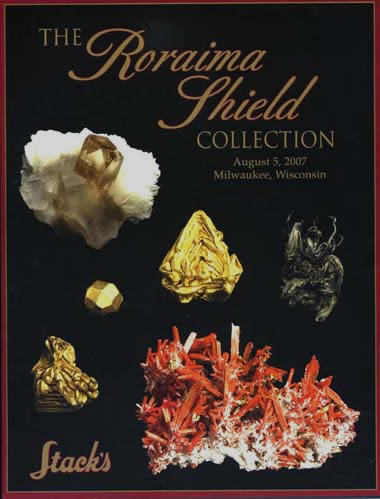 |
This world class collection highlights some of the finest crystalline gold specimens found on Earth. They were collected between 1979 and 1996 from several mining localities near St. Elena, Venezuela. This array of gold crystals ranges from wires to octahedra to mind boggling free forms. The Big Four, as they are called (below), are the finest of the collection, and are said to be some of the most important such specimens held in private hands. [back to top]
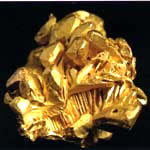 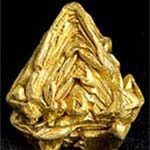 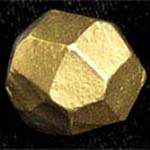 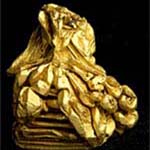 |
| The Big Four—amongst the finest crystalline gold, for size and form. We’ve been informed that the trapezohedron at lower left has been “withdrawn for further study,” indicating that its crystalline authenticity is in doubt. The three stacked octahedra, however, all have been verified. |
Stephen Smale Shows Off New Acquisitions
By Bill Larson
Renowned UC Berkeley mathematician and world class mineral collector Steve Smale held one of his “mineral parties” in July. His purpose? Fun and sharing his new acquisitions. This year’s main attraction was the display of much of his famous Chinese mineral collection.
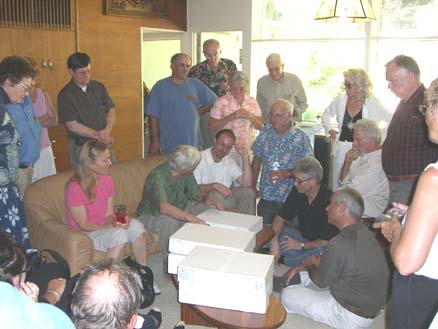 |
| Afternoon showing. Steve Smale (center, in green shirt) showing the crowd his new world-wide acquisitions, one by one from a dozen or so flats—all new since Tucson, and each one a jewel for any collector’s taste. (Photo: Bill Larson) |
Many members from the Crystal Gazers club in San Francisco were in attendance, including Jack Halpern, Jon and Nancy Sigerman and their son Max, Paul Geffner, Caroline Manchester, and Si and Ann Frazier. Many out-of-town guests also came from Dallas, including Jim and Gail Spann and Rob Lavinsky; from the Denver area, Dave Bunk, Steve Behling, and Richard Jackson; from Tucson, Ken Roberts; and from Southern California, Wayne and Dona Leicht, and Jeanne Larson and myself. Clara Smale had set up the usual beautiful buffet with a large poached salmon being a hit, along with a fine selection of many California wines. An animated, exciting time was had by all who attended.
Smale is the author of The Smale Collection: Beauty in Natural Crystals. [back to top]
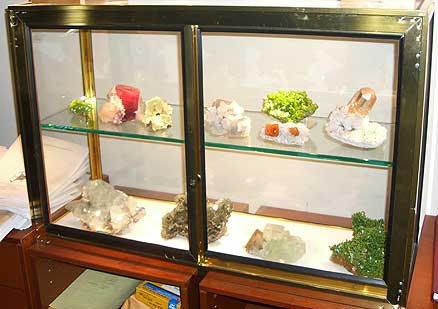 |
| China cabinet. A small case housing some of the Smale China collection. This case has a gem topaz on matrix that anyone would envy, and several wonderful pyromorphites. (Photo: Bill Larson) |
Books and Periodicals
Namibia: Minerals and Localities
by Ludi von Bezing, Rainer Bode, and Steffen Jahn
in Collaboration with Peter Lyckberg, Olaf & Ulrike Medenbach,
Gerhard Niedermayr & Gabi Schneider
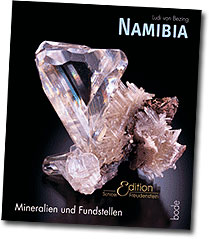 |
Namibia is more than a book, weighing in at 9.3 lbs., it’s everything you would ever want to know about minerals from this dramatic land, and more. This volume is an expanded version of the first edition which came out in German in 2002. A beautifully illustrated behemoth divided into two main sections: the 15 main mineral localities and the encyclopedia of minerals of Namibia from A to Z.
The 850 pages and 1,600 full-color images take us on a journey from Namibia’s prospecting history through the legendary Tsumeb mine, and the famous collections and collectors that were spawned from these mineral rich lands.
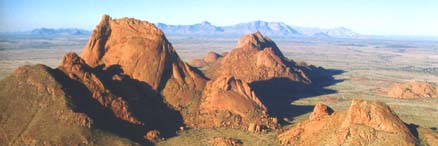 |
| “Matterhorn of Namibia.” These 700-million-year-old peaks, the Greater Spitzkoppe, rise dramatically up to 700 feet above the plain. |
We include here some images from the book: the iconic Greater Spitzkoppe outcrop (above), near Brandberg, and some unusual colors and habits for smithsonite (below), exhibiting the strange geologic conditions and unusual chemical mixtures that have created some of the most rare and beautiful mineral specimens on the planet.
To view sample pages of Namibia visit the publisher, Bode Verlag.
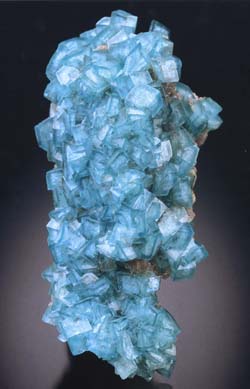 |
| Blue smithsonite in rhombohedral crystals (Tsumeb Mineral Gallery page 224, Houston Museum of Natural Science) |
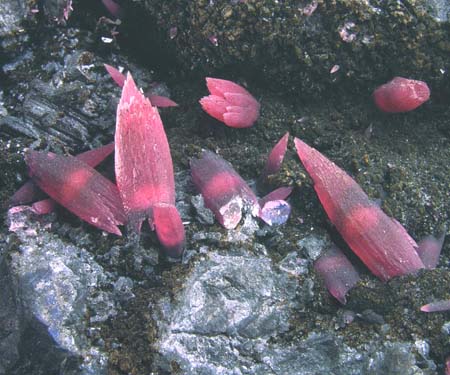 |
| Rose smithsonite colored red by the presence of cobalt. (Tsumeb Mineral Gallery, page 220, Pohl/Schloss Freudenstein collection) |
[back to top]
Mines: Colorado School of Mines Magazine
 |
Mines, the magazine of the Colorado School of Mines, is now online. Now under the editorship of Nick Sutcliffe, the current issue (Spring/Summer) includes three feature articles on sustainable and renewable energy.
A website-only attraction is called “Cool Extras.” The page currently features MP3s of Colorado Gov. Bill Ritter’s speech to the Mines community and a talk delivered May 12 by Mines alumnus Mahdi Obeidi, Saddam Hussein’s former chief nuclear scientist. [back to top]
Mineralogical Publications from Canada
 |
Our friend George Harlow, of the American Museum of Natural History, sent us information on publications being offered by the Mineralogical Association of Canada.
An example of what’s offered: Geology of Gem Deposits, edited by Lee A. Groat, of the University of British Columbia. The book covers the major gemstone species, as well as colored gemstones of Canada. It’s the thirty-seventh “short course” volume in a series that includes the topics of infrared spectroscopy, melt and fluid inclusions, and older classics. [back to top]
— End August Newsletter • Published 8/1/07 —